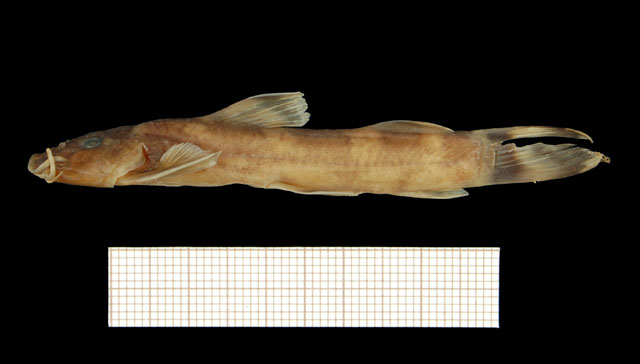|
Dorsal spines (total): -0; Dorsal soft rays (total): 7; Anal spines: -0. Diagnosis: eyes closely spaced (interorbital width 1.2-1.9 times orbit diameter); pigmentation brown with light bands, dark band across base of dorsal; origin of dorsal fin less than one head length behind head; dorsal base before origin of pelvic fins; dorsal leading ray extends full length of leading edge of fin; caudal fin with 6+7 principal rays; caudal peduncle length 1.18-1.47 times depth; snout half of head length; eyes placed equidistant from hind margin of head and tip of snout (mid-way along head) or nearer to tip of snout (Ref. 81646).
Description: body stout, depressed anteriorly, width tapering to a compressed caudal peduncle; head length 3.5-3.9 times in SL, depressed and rounded anteriorly; branchiostegal membrane deeply cleft mid-ventrally; mouth broad, subterminal, with lips thick and fleshy; jaw teeth caniniform in bands; 3 pairs of filamentous barbels, maxillary longest, subequal to head length; snout moderately long; nostrils in mid-snout, narrowly separated; eyes moderately sized, confluent with head (orbital margins attached); caudal peduncle short (5.9-7.1 times in SL), slightly longer than deep; fins well-developed; dorsal fin with 1 unbranched and 6 branched rays, its base entirely in advance of pectorals, rectangular with leading simple ray equal to length of leading edge; pectoral fins with 1 unbranched and 9 branched rays, not reaching pelvics, rounded with leading ray curved, padded and pectinate, innermost (posterior) rays align vertically against body wall; pelvics fins with 1 unbranched and 5 branched rays, broad, with padded pectinate leading ray, not reaching base of anal; anal fin with 2-3 unbranched and 4-5 branched rays, short, not reaching base of caudal; caudal fin with emarginate hind edge, ventral lobe slightly longer than dorsal lobe; adipose fin well-developed, rounded, base extends from before origin of anal to base of caudal procurrent ridge (Ref. 81646).
Coloration: head and body usually dark brown with 4-5 light saddle bands and a light off-white ventral surface from head to anal fin; fins with brown rays; caudal fin with broad dark brown basal band and a distal band (Ref. 81646). |

